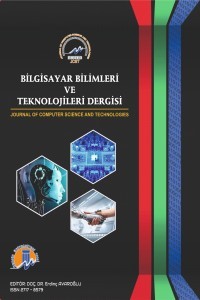COVID-19 veri seti kullanarak ön-eğitilmiş modellerin sınıflandırma performanslarının karşılaştırılması
COVID-19, 2019 yılında Çin’in Wuhan kentinde ortaya çıkan ve SARS-CoV-2 virüslerinin neden olduğu bir salgındır. Bu salgın, virüsün yüksek bulaşıcılığa sahip olmasından dolayı hızlı bir şekilde tüm dünyaya yayılmıştır. SARS-CoV-2 virüslerinin gösterdiği semptomlar, diğer hastalıklarla benzerlik gösterebilmekte ve bu virüse maruz kalanların hastalıkları viral pnömoni ile karıştırılabilmektedir. Bundan dolayı hastalığın teşhisinde, doktorlara ve araştırmacılara yardımcı olmak için bilgisayar destekli teşhis sistemlerinden faydalanılmaktadır. Bu çalışmada, 3 sınıf içeren COVID-19 veri seti, öğrenme aktarımı yöntemi kullanılarak sınıflandırılmıştır. Veri setinin %80’i eğitim, %20’si test verisi olarak ayrılmıştır. Ön-eğitilmiş modeller kullanılarak oluşturulan sınıflandırıcılar eğitilmiş ve elde edilen modellerin test verisi için doğruluk oranları InceptionV3, Xception, InceptionResNetV2, VGG19, ResNet152V2, DenseNet201 tabanlı modeller için sırasıyla %98.6, %98.7, %99.3, %97.8, %98.7 ve %98.0 olarak hesaplanmıştır. Bu sonuçlar, ön-eğitilmiş modeller kullanılarak oluşturulan sınıflandırıcıların, COVID-19 salgınında teşhis aşamasında doktorlara yardımcı olabileceğini göstermektedir.
Anahtar Kelimeler:
sınıflandırma, covid-19, makine öğrenmesi, öğrenme aktarımı, ön-eğitilmiş modeller, pre-trained models
Comparison of the classification performances of pre-trained models using the COVID-19 data set
COVID-19 is a pandemic that originated in Wuhan, China in 2019 and is caused by SARS-CoV-2 viruses. The pandemic quickly spread all over the world due to the high contagiousness of the virus. Symptoms exhibited by SARS-CoV-2 viruses can be similar to other diseases and diseases of those exposed to the virus can be confused with viral pneumonia. Therefore, computer-aided diagnosis (CAD) systems are used to assist doctors and researchers in the diagnosis of the disease. In this study, the COVID-19 data set, which includes 3 classes, was classified using the transfer learning method. 80% of the data set is separated as training and 20% as test data. Classifiers constructed using pre-trained models were trained and the accuracy rates for the test data were obtained as %98.6, %98.7, %99.3, %97.8, %98.7 and %98.0 for InceptionV3, Xception, InceptionResNetV2, VGG19, ResNet152V2, DenseNet201 models, respectively. These results show that the proposed classifiers based on pre-trained models can assist doctors in the diagnosis of the COVID-19 outbreak.
Keywords:
classification, covid-19, machine learning, transfer learning,
___
- Rochmawati, N., Hidayati, H. B., Yamasari, Y., Yustanti, W., Rakhmawati, L., Tjahyaningtijas H. P. A. ve Anistyasari Y. (2020). Covid symptom severity using decision tree. 2020 Third International Conference on Vocational Education and Electrical Engineering (ICVEE), 1-5.
- Mishra, M., Parashar, V. ve Shimpi, R. (2020). Development and evaluation of an AI System for early detection of Covid-19 pneumonia using X-ray (Student Consortium). 2020 IEEE Sixth International Conference on Multimedia Big Data (BigMM), 292-296.
- Tabik S., Gómez-Ríos, A., Martín-Rodríguez, J. L., Sevillano-García, I., Rey-Area, M., Charte, D., Guirado, E., Suárez, J. L., Luengo, J., Valero-González, M. A., García-Villanova, P., Olmedo-Sánchez, E. & Herrera, F. (2020). COVIDGR dataset and COVID-SDNet methodology for predicting COVID-19 based on chest x-ray images. in IEEE Journal of Biomedical and Health Informatics 2020, 24(12), 3595-3605.
- Wang, X., Deng, X., Fu, Q., Zhou, Q., Feng J., Ma, H., Liu, W. & Zheng, C. (2020) A weakly-supervised framework for covıd-19 classification and lesion localization from chest ct. in IEEE Transactions on Medical Imaging 2020, 39(8), 2615-2625.
- Chowdhury, M. E. H., Rahman, T., Khandakar, A., Mazhar, R., Kadır, M. A., Mahbub Z. B., Islam, K. R., Khan, M. S., Iqbal, A., Emadı, N. A., Reaz, M. B. I. & Islam M. T. (2020). Can AI help in screening viral and COVID-19 pneumonia?. IEEE Access 2020, 8, 32665-132676.
- Szegedy, C., Vanhoucke, V., Ioffe, S., Shlens, J. & Wojna, Z. (2016) Rethinking the inception architecture for computer vision. 2016 IEEE Conference on Computer Vision and Pattern Recognition (CVPR).
- He, K., Zhang, X., Ren, S., & Sun, J. (2016). Deep residual learning for image recognition. 2016 IEEE Conference on Computer Vision and Pattern Recognition (CVPR), 770-778.
- Chollet, F. (2017). Xception: Deep learning with depthwise separable convolutions. In Proceed-ings of the IEEE Conference on Computer Vision and Pattern Recognition, 1251-1258.
- Szegedy, C., Ioffe, S., Vanhoucke, V., & Alemi, A. (2017). Inception-v4, inception-resnet and the impact of residual connections on learning. Thirty-First AAAI Conference on Artificial Intelligence, 31(1).
- Huang, G., Liu, Z., Maaten, L. v. d., & Weinberger, K. Q. (2017). Densely connected convolutional networks. IEEE Conference on Computer Vision and Pattern Recognition (CVPR).
- Wang, S., ve Zhang Y. (2020). DenseNet-201-based deep neural network with composite learning factor and precomputation for multiple sclerosis classification. ACM Transactions on Multimedia Computing Communications and Applications, 16(2), 1-19.
- Huang Z., Nasrullah, W. J., Song S., Mateen M. (2018). Fundus image classification using VGG-19 architecture with PCA and SVD. Symmetry, 11(1).
- URL-1: https://www.kaggle.com/tawsifurrahman/covid19-radiography-database [Erişim Tarihi: 15.11.2020]
- ISSN: 2717-8579
- Yayın Aralığı: Yılda 2 Sayı
- Başlangıç: 2020
- Yayıncı: Mersin Üniversitesi
Sayıdaki Diğer Makaleler
Makine Öğrenmesine Dayalı Mobil İngilizce Öğrenme Uygulaması
Esracan GÜNGÖR, Sinem AK, Zeynep ORMAN
HAVADA ve KARADA HAREKET EDEBİLEN 3 BOYUTLU TÜNEL HARİTALAMA ROBOTU
Öneri Algoritmalarının Film Önerme Problemi Üzerinde Karşılaştırılması: MovieLens Örneği
Muhammed BOZKURT, Çiğdem İnan ACI
Melisa UÇKUNER, Prof. Dr. Hamza EROL
Büyük veri analitiği için yüksek performans hesaplama: çözüm ortamları ve kodlama
